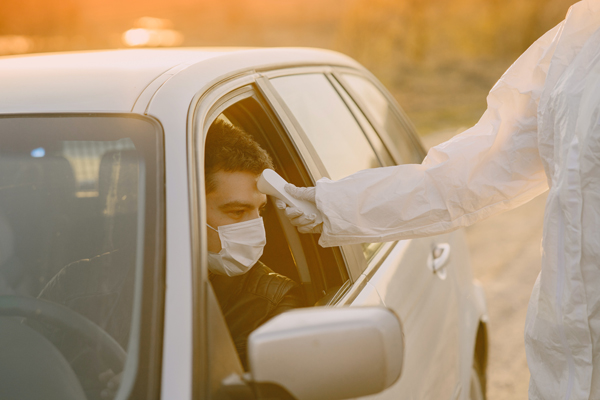Heat-related symptoms affected one-quarter of Americans during summer of 2020
Social distancing, economic hardships left Americans vulnerable to extreme heat
Aug 5, 2021 - by David Hosansky
Aug 5, 2021 - by David Hosansky
During the pandemic summer of 2020, more than one-quarter of the U.S. population suffered from exposure to extreme heat, according to a new study led by the National Center for Atmospheric Research (NCAR). The heat-related symptoms that people reported, ranging from nausea and muscle cramps to more serious conditions such as fainting and confusion, occurred as the economic downturn and social distancing made it harder to escape sweltering temperatures.
The study found that the people who were most vulnerable to the impacts of summer heat included women, those in low-income households or who were unemployed or furloughed, and those who identify as Hispanic or Latino or other non-white populations.
The research team surveyed thousands of people to determine the effects of heat at a time when millions of Americans were out of work and fears about the spread of COVID-19 led officials to temporarily shutter community centers, libraries, and other cooling centers.
“The two health hazards of extreme heat and COVID-19 intersected in a way that magnified existing vulnerabilities and put millions of Americans at risk from heat stress,” said NCAR scientist Olga Wilhelmi, the lead author. “The nation’s safety nets proved to be very fragile.”

The surveys found that high numbers of people found it more difficult than normal to change their routines and escape high temperatures, or to access good medical care. Although most Americans have air conditioning, about one in five respondents could not adequately cool their homes, often because of the high costs of running or maintaining their air conditioners.
“This study emphasizes how social and economic inequalities magnify the risks from environmental hazards,” said co-author Peter Howe, an associate professor of geography at Utah State University. “Heat is already one of the deadliest weather hazards in the US, with the greatest burden on low-income and marginalized populations. Our work shows that many people who were already at high risk from heat were put at even greater risk by responses to the COVID-19 pandemic."
The study, which will be published in Environmental Research Letters, was funded by the National Science Foundation, which is NCAR’s sponsor. Scientists from Utah State University and the University of Colorado–Colorado Springs co-authored the study.
Even in non-pandemic times, extreme heat poses major health risks by potentially causing dehydration and heat stroke as well as exacerbating cardiovascular and respiratory disease. Those who suffer from energy poverty and cannot keep their homes cool are at the highest risk, especially people who are elderly or very young, or have pre-existing medical conditions.
To protect their most vulnerable residents, local governments have pursued such measures as establishing designated cooling centers for temporary escape from the heat and developing community-based programs that strengthen social networks and provide support for those in need. These strategies, however, were undercut by the economic hardships and social isolation associated with the pandemic.
To measure the impact of heat on Americans during the spread of COVID-19, Wilhelmi and her colleagues administered online surveys to more than 3,000 adults in July, August, and September of 2020. They asked about extreme heat perceptions and experiences, symptoms of heat stress, strategies to escape the heat (including using air conditioning and changing routines to avoid getting overheated), and the challenges of taking protective actions during the pandemic. The results had an average margin of error of 3% with a 95% probability, or confidence interval, of correctly capturing the mean for the overall population.
The surveys found that almost 28% of Americans reported having one or more symptoms that they believed were related to extreme heat. Nearly one-third expressed some degree of worry about heat while they were working, and one in eight said they had decreased productivity while working in very hot weather. Those in the lowest household income group were 68% more likely to experience at least one heat-related health symptom than those in the highest income group. By race and ethnicity, non-white respondents, and especially those who were Hispanic/Latino, were most likely to report heat symptoms.
Geographically, those in the South and West were most likely to report heat-related ailments. The study did not examine the reasons for this, but the research team is currently taking a closer look at possible environmental and health factors. Wilhelmi said they may be related to the heat and humidity of the South and the comparative lack of air conditioning in the West.
Asked about the effects of the pandemic, more than a quarter of respondents reported feeling isolated at home, and more than one in five said it was more difficult than during an average summer to check on family and friends. Those who felt too hot at home said it was difficult to go to an air-conditioned place or get medical care, and they also were more likely to say they were worried about COVID-19.
“Energy poverty has been a persistent problem in the U.S., and the pandemic exacerbated existing socioeconomic inequities and overwhelmed emergency response systems,” Wilhelmi said. “Looking ahead, it’s critical that local, state, and federal officials have the necessary resources to safeguard the health of the most vulnerable in a multi-hazard situation.”